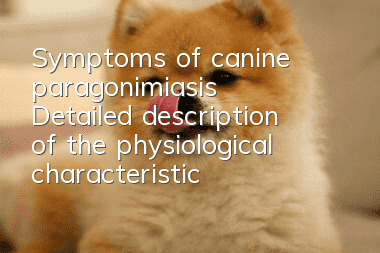Symptoms of canine paragonimiasis Detailed description of the physiological characteristics of canine paragonimiasis

Canine paragonimiasis
Paragonimiasis is also known as leech. Because the pathogen belongs to the genus Paragonimus, it is also called Paragonimiasis. There are many types of Paragonimus, the most common of which is Paragonimus guarderi, which is parasitic in the lungs, meninges and trachea of dogs and cats and is mainly prevalent in Zhejiang, Taiwan and Northeast China. A type of Paragonimus stephensi is also found in Guangdong, Sichuan, Jiangxi and Guizhou provinces. It usually lives in subcutaneous nodules and rarely damages the lungs.The pathogen of canine paragonimiasis and its life history
Paragonimus guarderi is dark red, 7.5~16 mm long, 4~8 mm wide, with a raised back and a flat ventrally. , much like half a red bean. The parasites often live in pairs in the sacs formed by the lung tissue, and the sacs are connected to the bronchial tubes. The eggs are swallowed into the digestive tract along with the host's sputum, excreted through the feces, and miracidia hatch out in the water. They invade into the first intermediate host, freshwater snails, divide and multiply, go through the development stages of cysts and ranidae, and finally develop into a large number of cercariae. Escape from the snail, invade the second intermediate host (crab), and become metacercariae. Dogs and cats eat raw or half-cooked crabs containing metacercariae, which break out in the small intestine, pass through the intestinal wall, abdominal cavity, diaphragm and pleura to the lungs, and then develop into adult worms.Key points for diagnosis of canine paragonimiasis
The common clinical symptoms are cough, which may be accompanied by hemoptysis, asthma, fever and diarrhea, and the feces is black. Combined with the analysis of clinical symptoms and epidemiological data, the diagnosis can be confirmed by detecting eggs in sputum and feces.Measures for the prevention and control of canine paragonimiasis
First, use pyrazolone to deworm, at a dosage of 50 mg/kg body weight, orally, for 3 to 5 days. Or use thiodichlorophenol, the dosage is 100 mg/kg body weight, orally, administered to children every day or every other day, 10 to 20 treatment days is a course of treatment.Second, in areas where the disease is endemic, it should be prohibited to use fresh crabs as feed for dogs and cats.
Random articles
- What should I do if my dog accidentally eats leeks?
- Diagnostic Methods for Unexplained Fever in Dogs and Cats
- Dog keeps swallowing saliva, licking tongue and burping
- How many days is the dangerous period for a dog to be hit by a car? What should I do if my dog is hit by a car?
- Can dogs take a bath? You need to know the precautions!
- What are the causes of dandruff on dogs? Let’s see what causes it.
- Is it necessary to get an injection if a dog bites and bleeds? Injection is a crucial step to save life!
- What should I do if my dog likes to bite? How to correct this bad habit of my dog?
- What is the latest time to give rabies vaccine? The earlier the better
- Where to get a dog license? In fact, it is not difficult to get a dog license.



